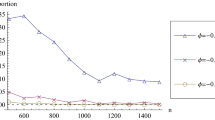Abstract:
We investigate the potential of the analysis of noisy non-stationary time series by quantising it into streams of discrete symbols and applying finite-memory symbolic predictors. Careful quantisation can reduce the noise in the time series to make model estimation more amenable. We apply the quantisation strategy in a realistic setting involving financial forecasting and trading. In particular, using historical data, we simulate the trading of straddles on the financial indexes DAX and FTSE 100 on a daily basis, based on predictions of the daily volatility differences in the underlying indexes. We propose a parametric, data-driven quantisation scheme which transforms temporal patterns in the series of daily volatility changes into grammatical and statistical patterns in the corresponding symbolic streams. As symbolic predictors operating on the quantised streams, we use the classical fixed-order Markov models, variable memory length Markov models and a novel variation of fractal-based predictors, introduced in its original form in Tin_ o and Dorffner [1]. The fractal-based predictors are designed to efficiently use deep memory. We compare the symbolic models with continuous techniques such as time-delay neural networks with continuous and categorical outputs, and GARCH models. Our experiments strongly suggest that the robust information reduction achieved by quantising the real-valued time series is highly beneficial. To deal with non-stationarity in financial daily time series, we propose two techniques that combine ‘sophisticated’ models fitted on the training data with a fixed set of simple-minded symbolic predictors not using older (and potentially misleading) data in the training set. Experimental results show that by quantising the volatility differences and then using symbolic predictive models, market makers can sometimes generate a statistically significant excess profit. We also mention some interesting observations regarding the memory structure in the series of daily volatility differences studied.
Similar content being viewed by others
Author information
Authors and Affiliations
Rights and permissions
About this article
Cite this article
Tinù, P., Schittenkopf, C. & Dorffner, G. Volatility Trading ia Temporal Pattern Recognition in Quantised Financial Time Series. Pattern Analysis & Applications 4, 283–299 (2001). https://doi.org/10.1007/PL00010989
Issue Date:
DOI: https://doi.org/10.1007/PL00010989




